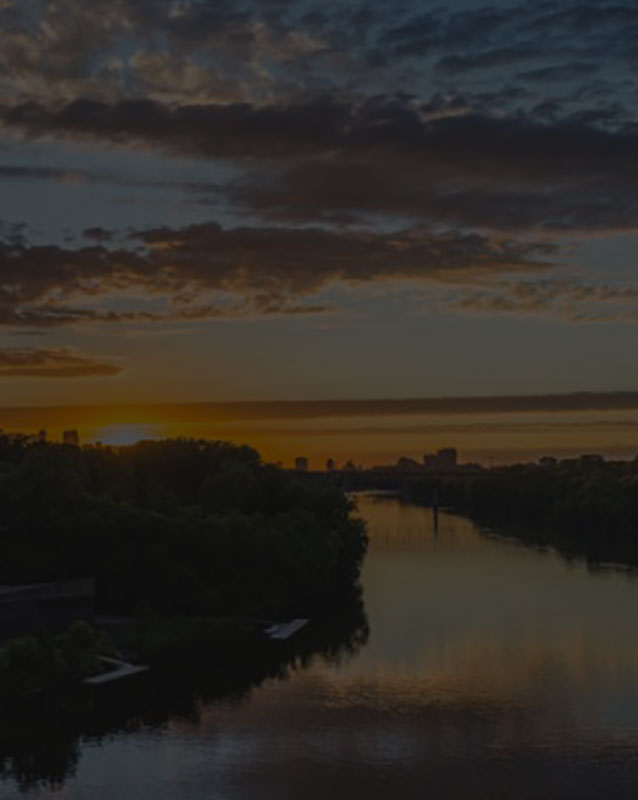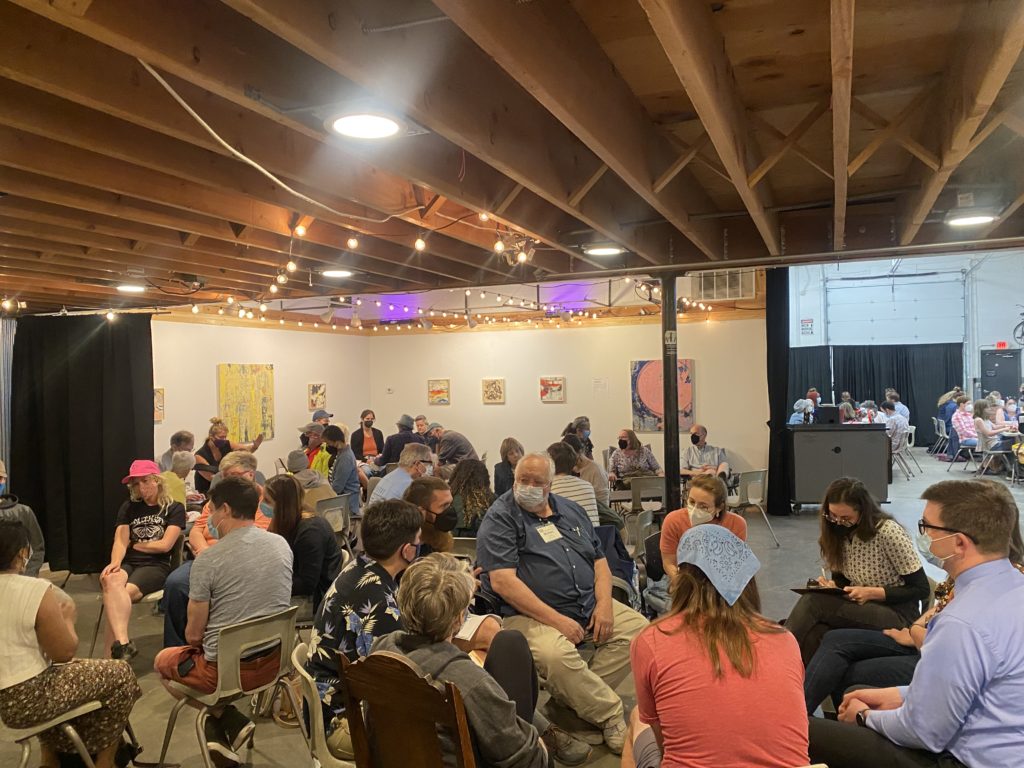The 3rd Precinct site at Minnehaha and Lake remains barricaded and unused. Community input on what happens to the building is the beginning of continued conversations and hopefully, actions for rehabilitation by the City of Minneapolis. See the PDF report on these conversations we have sent to City officials. It is imperative that the City continues to inform residents of their plans and engage in outreach to the entire community. We hope that our report, and this crucial input from residents, help shape City-led initiatives that put the community’s needs at its core.
It is clear that the community is invested in what happens to the 3rd Precinct site. Between our two conversation sessions we had over 150 people, most of them living in Greater Longfellow, discuss their visions for the 3rd Precinct site. In both the virtual and in-person sessions, attendees were placed into small groups where they had a chance to share their thoughts on whether the 3rd Precinct site at Lake and Minnehaha should remain a police precinct or be transformed into a different use. This was the first time many were able to talk with their neighbors of different backgrounds and generations to bring ideas forward and learn from each other in a respectful, open, and directed way.
Around 75 percent of people who attended these conversations said they do not want to see the 3rd Precinct relocated at the corner of Minnehaha Avenue and Lake Street. That site is a place of trauma for the community and for the city to relocate MPD in that building would retraumatize the neighborhood and would be disrespectful to the healing process, which is ongoing. To put MPD back at the 3rd Precinct site would be to deny the events surrounding the murder of George Floyd and the civil uprising and to ignore the injustices members of our community face at the hands of police.
While there was disagreement among community members about MPD’s place in the community, and if they should be there at all, there was a consensus that without reform of the MPD their presence in the community will be a source of harm. The trauma did not start on May 25, 2020 and without addressing the systemic problems within the Minneapolis Police Department, as addressed in the Minnesota Human Rights report, many feel that the problems will persist and leave the community vulnerable to further retraumatization. But there was support for having MPD back in the community in some capacity.
Several people who did not want to see MPD return to the 3rd Precinct site, did want the police back in the neighborhood, but where was a harder question to answer. Some people suggested smaller, satellite offices throughout the neighborhood to integrate police into the community, which is often cited as a strategy in reform. Others mentioned that there were other spots in the community better suited for a police building, or suggested they locate in a more industrial part of the city. There were also many people who didn’t want the police back in the neighborhood at all.
Community members have expansive and creative ideas as to how the 3rd Precinct site could be transformed – some advocated for a business or community hub that would contribute and enliven that space as a cultural corridor to our neighborhood. Many want to see that space used to serve the community in some capacity: social services, youth focused space, affordable housing, a space to serve BIPOC and small businesses, alternative policing organizations, activated green space, a memorial to the movement, or some combination.
Almost everyone who attended either session stated that the building cannot remain in its current condition and some action must be taken. As it stands, the building is a blight to the neighborhood, and hinders pedestrian accessibility.
There is still much healing to be done, and many said a restorative justice process needs to happen before we can begin healing from the trauma experienced as individuals and as a community. Community members largely agreed that the City is not the appropriate steward to carry out this healing and some saw reform of MPD as the primary response the City could take to address healing in the community and the distrust between residents and MPD and the City at large.
There was a call for funding from the City to contractors or resources the community could access to help with healing, as many feel that not enough has been done to address the trauma of the community, nor has the City provided resources. Many residents feel that the City has failed them in trauma support following the civil uprising and historically feel as if the City hasn’t addressed issues of injustice, safety, and equity, furthering the distrust.
“I recognize at the City there is a distrust in the enterprise to carry this out. Bringing in someone with a restorative background with not only the people that are here, but all those who aren’t who were impacted and touched by events of George Floyd and have a stake in how they would like to see that site reimagined,” Ward 2 Council Member Robin Wonsley said. “I don’t want us to reassert something that maintains the status quo. I want this to be something we can point to and say Minneapolis got it right. I want to have a beautiful, healing, restorative, deliverable and show the world that we are committed to doing better.”
Community members were able to bring their questions to City officials. We also collected questions from the community to pass on to the City. Overwhelming, attendees called for more information from the City, more transparency, and more action.
“I think moving forward as the City of Minneapolis, one thing we need to ask ourselves is what do we actually do? How do we address the trauma that happened all over Minneapolis and here across our ward and our district?” Ward 9 Council Member Jason Chavez said. “The one thing is that I’m going to continue to advocate for more conversations with the City and I think that whatever we do, we should do it with community in mind. This should be led from the bottom to the top and as your representatives we should be taking action from what we hear.”
The City must continue these conversations and work to engage all members of the community, especially those who are more adversely impacted by policing. The attendees for these conversations were 77 percent white, 10 percent Black, 4 percent Latinx/Hispanic, 2 percent Asian or Asian American, and 8 percent other.
Thanks to all of the residents, City Staff, and City Council members Chavez and Wonsley who attended our 3rd Precinct Conversations. Thanks to sponsors: Lake Street Council, Longfellow Business Association, Seward Redesign, Longfellow Rising and Seward Civic & Commerce Association.
The City’s plan and some financing information as stated at the events are available below. Most of these questions were answered by the City Coordinator’s office. Please note that these are not direct quotes, but information gathered from officials during our Q&A.
PLAN & TIMELINE
- City officials said they wanted to hear from the community first on whether they want it to continue to be an MPD building or something else before executing a plan.
- They acknowledged that their communication around this issue has not been good.
- There was a plan to move the 3rd Precinct to another site in the neighborhood, but due to protests, the property owner backed out. Officers of the 3rd Precinct are currently operating out of downtown.
- The city is working on a timeline. They have hired a Race & Equity Director who will largely be in charge of the reconciliation process. They want to use this opportunity to develop a timeline.
FUNDING
- The current site would cost around $7 million to reconstruct.
- The City doesn’t have an official number on rebuilding a new precinct, but it could be between $14 million and $20 million and any cost would largely depend on the new site.
- The City will get funds from FEMA to rebuild, but they don’t know the exact amount.
- The City is self-insured so no insurance money was received from damage to the building.
TRANSFORMING THE SITE AT LAKE & MINNEHAHA
- The City has a land disposition policy that has to be followed in regards to what the use of that site could be. They can sell land for market rate or for community uses, but there are restrictions on when the City can sell land. With any sale or determined use, the City is required to hold a public hearing and get City Council approval.
- There has not been a decision made about the location of the 3rd Precinct. The City has been looking at other sites for an alternate location.
POLICING & NEW POLICE CHIEF SEARCH
- The City has hired a recruitment firm to help with the hiring process. The firm has met with the City’s safety group and met with community leaders. They are still doing that engagement, the outcome of which will be reflected in the final position profile.
- As a result of the Minnesota Department of Human Rights report, it is likely that the City of Minneapolis will enter into a consent decree with MDHR, which will shape a lot of the recommendations named in that report.
- There is currently a Department of Justice investigation into MPD that will likely result in another consent degree.
- With the reported dysfunction and mistrust in the department, in addition to the two consent decrees, the challenge is going to be getting someone to come here knowing what is here. We can be accountable to deliver every single reform on that decent decree. The new chief needs to have a history of transformation and be ready to reform the department and change the culture and they will need support in that process.



